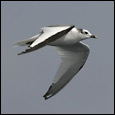
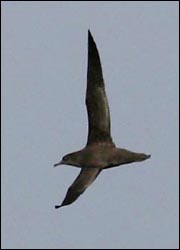 |
| A
graceful Sooty Shearwater! Photo: Göran Ekström, 2003 |
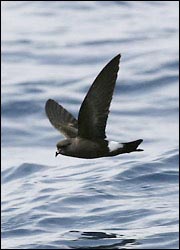 |
| Wilson's
Storm-petrel at sea. Photo: Göran Ekström, 2003 |
Is a seawatching trip to Senegal really worth paying for, bearing in mind the rather expensive flight tickets compared to many other hot birding destinations? The answer is undoubtedly yes if you wish to experience something few have done before you. There are not many sites in the world that can compete with the N'Gor area when it comes to observing large numbers of the three smaller skuas, four species of white-rumped Storm-petrels (with the possibility of White-faced Storm-petrel), shearwaters of the Calonectris complex (Cape Verde, Cory's and Scopoli's), the instructive mix of tern species including African Royal Tern and Lesser Crested Tern and still with a chance of seeing something completely unexpected. Other shearwater species, Catharacta skuas, gulls (e.g. Sabine's and Audouin's) and Grey Phalarope not to be forgotten!
Besides spring sessions when high numbers of Wilson's Storm-petrels can occur, the autumn is the best period for seawatching. The true Senegal seawatching pioneers are undoubtedly the French birders François Baillon and Philippe Dubois, whom discover the high potential of the area already in 1990. They were followed by another French team in 1991 and thereafter by a British team of birders (mainly Dick Newell, Richard Porter, Tony Marr and Robin Jolliffe) who have counted seabirds off N'Gor periodically each autumn since 1995. However, their coverage of N´Gor has only been from the beginning of October to the beginning of November. Therefore, September, late November and December remain unexplored and are interesting periods for pioneering seawatchers yearning for discoveries. The potential to learn and discover new things about this mysterious group of birds is still enormous, especially regarding identification, moult and migration patterns!
Whichever reasons you may have to visit Senegal for seawatching (identification, migration counts or just sheer enjoyment), you will not leave the country unaffected or with blank pages in your notebook!
Seawatching
sites
After your flight has landed on the international airport (Léopold
Sédar Senghor) north of Dakar and you are through immigration,
baggage pick-up and customs and have been struck by the warm humidity,
it is time to find a taxi. No worries about this, the taxi drivers will
find you! Try to be calm but in the same way resolute and let no one carry
away your bags! As you are a seawatcher you are surely heading for the
Diarama Hotel or the nearby bungalows at Club le Calao at N'Gor. The taxi
ride from the airport to N'Gor will take about 5-10 minutes depending
on the driver's liking for speed.
There are two very good sites for seawatching located on the western tip
of the Cap Vert peninsula, both in the N'Gor area. In this area there
are only two places to stay, the already mentioned Diarama and Club le
Calao. When staying at Club le Calao (recommended) you only have minutes
to their excellent restaurant terrace next to the sea, which is a brilliant
vantage point for seawatching. The other hotspot is located on the north
side of the small island Isle N'Gor, which is accessible by regular boat
service from N'Gor Beach, within 10 minutes walking distance from Club
le Calao and Diarama. Both places are quite similar and the differences
in seawatching conditions are marginal.
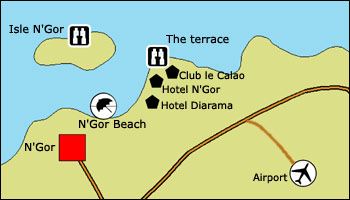 |
| Map over the N'Gor area. By Martin Åkesson, Sweden. |
The terrace at Club le Calao
The British seawatchers have always chosen the high-rise and unappealing Diarama Hotel as their accommodation. The rooms and their balconies on the third our fourth floor facing the sea are well suited for seawatching and the seabirds that may pass in the strait between N'Gor Beach and the island Isle N'Gor are well covered from there, but seabirds passing offshore from the island are too distant. The Swedish seawatchers that visited Senegal in October 2003 found that the accommodation in Club le Calao's bungalows was both cheaper and more pleasant. To their surprise they discovered the restaurant terrace next to the sea to be an excellent spot for watching seabirds from.
Advantages (compared to Isle N'Gor): You always start the day here as you eat your breakfast in or outside the terrace, from where you very fast become aware of the wind direction and the numbers of seabirds passing already in the light of dawn. If the conditions seem promising, you can decide to relocate and take the boat to Isle N'Gor. The terrace is located only a minute from the accommodation, a big parasol, food, drinks and a cooling pool add to the comfort.
From the terrace you can often follow many seabird species, especially terns, gulls and skuas (e.g. Arctic Skuas) for a rather long period of time. For example, nearly all Caspian and Little Terns and the smaller Gulls (except Sabine's) pass through the strait, and would therefore not be visible to you if you had chosen the north side of Isle N'Gor as an observation point.
Disadvantages: Smaller seabirds such as Storm-petrels generally pass further out compared to Isle N'Gor. Seabirds that migrate close the sea surface (for example Storm-petrels, Bulwer's, small shearwaters and Grey Phalarope's) are difficult to track uninterrupted as you sit lower on the terrace than on Isle N'Gor and the birds thus disappear in the wave troughs.
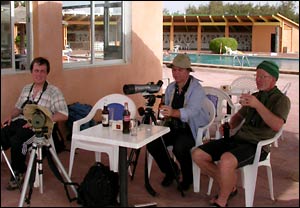 |
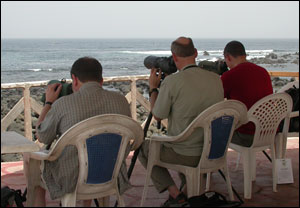 |
|
| Calao's
terrace offer sunshade all day long, drinks, food and a cooling pool
(in background) Photo: Niklas Holmström, October 2003. |
Seawatching
from the terrace at Calao, often allow longer observation time on
most seabirds. Photo: Niklas Holmström, October 2005. |
|
|
|
||
Isle N'Gor
As said before, the British seawatching groups have always used Isle N'Gor
as a land-based vantage point. Its situated less than a kilometre off
N'Gor Beach on the mainland and the big pirog (boat) services the island
about every 10 minutes. So, there are never any problems to reach the
island and get back from it before dusk! The crossing only takes a few
minutes and the boat lands on either the western or the eastern beach
on the south side. No matter which beach it lands on, it is only a few
minutes walk to reach the observation site on the northern side. When
you wish to get back to the mainland, you simply walk to one of the two
beaches and wait for the pirog, which always picks up passengers from
both beaches before it travels back. Remember, you always pay (500 CFA)
for a round trip when going out to the island and on the return you just
catch the boat you want. If the beer isn't finished you simply wait another
ten minutes for the next boat to take you back, while watching birds and
good-looking people on the beach. On the south side of Isle N'Gor you
will find many restaurants and small shops. For seawatchers, Isle N'Gor
is recommended for sessions during the morning. Unless the passage is
heavy, the latter half of the day should be spent on Calao's terrace.
Advantages (compared to Calao's terrace): Most seabirds pass close
to the shore, albeit sometimes too close. If you mostly use your scope,
a majority of gulls, terns and Arctic Skuas will be missed. Here, you
sit a bit higher above the sea than on Calao´s terrace, which means
you can follow many birds over longer periods. This is important when
recording flight action/style and plumage's. Small seabirds such as Storm-petrels
are certainly seen better here than at Calao's terrace. If you sit on
the eastern tip of the island you could discover many seabirds before
they pass by, but the eastern tip is not well-suited for larger numbers
of birders and you watch them from higher up. The middle of the north
side close to the 'Wall' is the best spot to seawatch from! If you want
to photograph seabirds from land, Isle N'Gor is definitely the best place
in the area!
Disadvantages: All seabirds that pass close the shore are easy
to miss, especially those who fly very low (and close) or high, even if
you use you binoculars. At Isle N'Gor it is better to alternate between
scanning with your scope and scanning with your eyes only. The thin and
airborne salt spray from the sea which covers the front lens of the scope
from time to time is obvious here, but non-existent at the terrace. There
are no comfortable facilities such as those mentioned at the Calao's terrace,
but who cares about comfortable things if it is a good seawatching day?
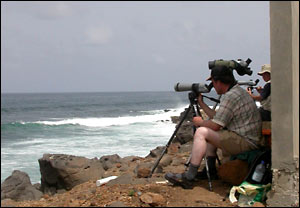 |
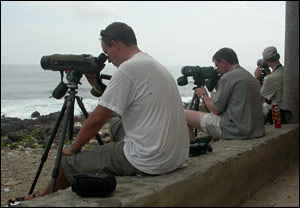 |
|
| At
Isle N'Gor the seabirds often pass closer to shore, sometimes too
close and are then easy to miss, especially skuas, gulls and terns. Photo: Niklas Holmström, October 2003. |
Seawatching
at the north side of Isle N'Gor, at the "new" about 50m
west of the "wall", as the latter turned out to be a rubbish
dump in 2005. Photo: Niklas Holmström, October 2005. |
|
Early
seawatching observations
In the article 'Seabirds off Senegal, West Africa', written by Tony Marr,
Dick Newell & Richard Porter (in Bulletin of the African Bird Club
1/1998), you can read more about observations made between 1968 and 1994.
Especially interesting are the observations made by the French pioneers
(Baillon and Dubois) between 28th August and 9th December 1990 (40 hours
seawatching) and by a French team (Alain Ferchal, Frédéric
and Emmanuel Gfeller and Olivier Laugero) between 30th July and 5th September
1991 (during a total of 145 seawatching hours): 10 Balearic Shearwaters,
756 Grey Phalaropes, 3.500 African Royal Terns, 15.300 Arctic Terns and
15.800 Black Terns!
Read
the article from 1990 here» (PDF
81 KB)
Copyright © 2004-2012, All rights reserved